Trip to Yumthang Valley
A travelogue which can tell you how to go to
Yumthang Valley in Sikkim
This is a travel account of the trip to Yumthang Valley in Sikkim made by
Thingnam Girija, N. Ullysess and Tabish, basically to find Himalayan
flowers, for the website, Flowers of India.
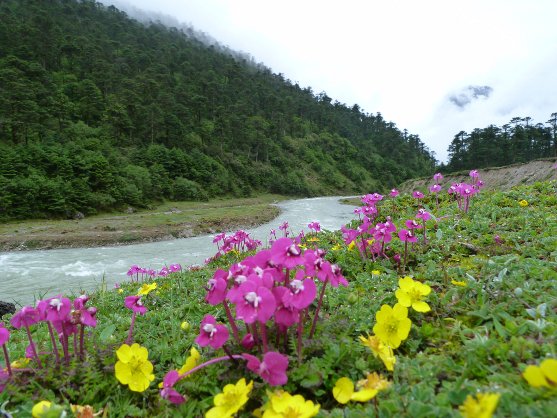
Yumthang Valley is a beautiful valley situated in north Sikkim. It sits
at an elevation of 3,500 metres above sea-level, so naturally home to many
beautiful Himalayan flowers. It is rightfully called a valley of flowers,
although that name is associated with the Valley of
Flowers in Uttarakhand. Yumthang Valley is extremely picturesque,
with green slopes covered with trees, yaks grazing in the flower-spangled
grassy plains below, and a river flowing right through the valley. The serene and
tranquil air of the Valley cannot be described in words. A single visit
there can leave the visitor in an enchanted state for weeks.
It also happens to be situated at what is called "the tree-line", the altitude
above which there are no trees. This makes the Yumthang Valley unique in
that it has trees and Rhododendrons, and yet abounds in tiny, low-growing
Himalayan flowers. The Valley has an astounding, over 24 species of
Rhododendrons which paint the Valley red in spring. Rhododendrons are shrubs
or trees, and different species of Rhododendron cover different large stretches
of the Valley. In spring, the Valley looks like a collage of little forests
of different colors. The flowering of
Rhododendrons is over by May end. During monsoons, starting in June, the
Valley blooms with all kinds of tiny Himalayan flowers, like the Primroses,
Cinquefoils, Louseworts and Cobra-lilies. This is a much more enchanting
scenario, but takes a keen viewer, with an eye for detail, to truly appreciate.
Large versions of the small pictures can be viewed by just moving your
mouse over the smaller pictures. But for this to work, all the big
pictures have to load first, which takes a little time - so, be patient.
The take-off: Bagdogra/New Jalpaiguri
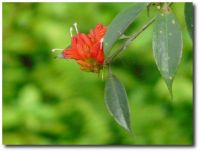
There is no direct way of going to Yumthang Valley - one has to first go
to the capital, Gangtok, and get permission to go to the Valley. Yes,
everybody needs permission to go to the Valley because of its proximity
with the Indo-China border. But first one has to reach Gangtok.
If you are travelling by air, which is getting
cheaper now-a-days, you should take a flight to Bagdogra in West Bengal,
a town which mostly serves as a connecting point to Sikkim and Darjeeling.
From inside the Bagdogra airport, one can get a prepaid taxi to Gangtok
for around Rs. 2000. Gangtok is 124 km from Bagdogra, and by road it
takes about 4 hours to reach there.
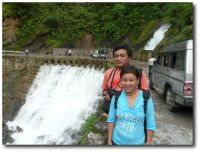
If you are travelling by rail, the nearest railways station is
New Jalpaiguri in West Bengal. All major trains going towards Guwahati,
pass through New Jalpaiguri. Coming from Bihar
side, you reach New Jalpaiguri just after passing through the
"Chicken's Neck" that connects NE India, with the rest of India. Gangtok
is 148 km by road from New Jalpaiguri.
Gangtok is a surprisingly polished town of NE India. The M.G. Marg
(Mahatma Gandhi marg), which is an equivalent of the "Mall roads" of various
hill-station, is really modernized. Go to M.G. Marg to look for a place to stay.
If you are looking for somewhat cheaper place, walk a bit uphill from the M.G.
Marg and explore the various hotels there.
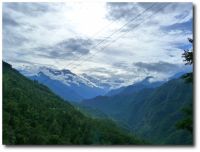
So, we reached Gangtok and check into a hotel. After a brief rest, we
straightaway head to a travel-agency to book a trip to Yumthang Valley.
Yes, you have to go through a travel-agency, and fill out a form, with
two passport-size photographs, and a photocopy of your voter-id card,
for each passenger. Because the Valley is
close to the Indo-China border, a permission is needed before you begin travel
towards Yumthang Valley. But don't let that put you off, because you won't have
to move a finger apart from filling out the form - everything else will be taken
care of by the travel agency. Also, even if you have permission to visit the
Valley, the actual permission for the vehicle to go will only come in the
morning of the day you are going to travel. That is because of the weather
and frequent landslides that block the roads. Only if the route is clear,
and the safety of the travel is assured, the authorities give a green signal
to go.
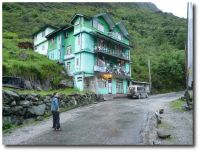
Assuming that you are going to take a shared vehicle, there are two packages
available for Yumthang. One is the two days, one night package which is very
popular, and the other one is three days, two nights. The one-night package
costs Rs 1,200 per person, which includes travel, stay overnight, and all
the meals during the tour. Not a bad deal! The two-nights package costs
around Rs 2,200 per person. The only problem is that many a times, there
are not enough takers for the two-nights package and the shared vehicle will
not go unless all the 10 seats are filled. So you might be forced
to take the one-night package, as happened in our case. There is a third
option, to book a vehicle just for yourself, plus the other things in the
package. That comes to around Rs 20,000 for the two-nights package.
You can see the arithmetic, shared Sumo takes 10 people, booking a full
vehicle would cost 10 times the shared cost of one passenger. All
we got was the one-night package, and the next morning the travel-agent
phoned us to inform that the permission has been granted. We pack our
luggage, check out of the hotel, and head for the vehicle.
If you are going to Yumthang, tavel light!

Another thing to keep in mind is to ask the travel-agency which vehicles are
they providing. Ten people in a Sumo or Mahindra-MaxX is not
uncomfortable, but it is uncomfortable in some, e.g. Bolero.
The itinerary is the following. From Gangtok, a 7 hours Sumo travel takes
you to Lachung, a small village 24 km before Yumthang Valley. You stay
in a hotel arranged by the travel-agency, and enjoy the simple free dinner.
Next morning, at 6 AM, start for the Yumthang Valley, which takes about
an hour. Come back to Lachung by 11 AM or so, and after an early lunch, start
back for Gangtok.
People of Sikkim are very nice and polite. Be gentle to them! Almost all
the people driving
hired vehicles are the owners of the vehicle, and well-educated too. So,
visitors, especially those from Delhi, should mind their attitude.
Journey to Lachung
Our journey begins on the hilly road, among lush green mountains, with milky
mountain brooks occasionally streaming down the slopes. The journey is
quite pleasant, apart from sitting immobile in the Sumo. We break the journey
for a cup of tea, and our eyes are already peeled for flower. We scramble
to photograph a beautiful white Dendrobium orchid that we had been looking
at throughout the journey, hanging from various trees. We also see a
beautiful pendulous shrub with scarlet tubular flower, which is called the
Sikkim Blushwort. We continue the journey, enjoying the views and listening
to the music playing in the Sumo. We stop at a dhaba-like place and the
pleasant people there are already expecting us, as arranged by the
travel-agency. We have a tasty lunch of dal, rice, 3 vegetables and papad.
We finish the lunch quickly and walk in search of some flowers before the
Sumo starts again. We find a few flowers, and enjoy the greenery, and the
smell of vegetation. Close to dark we reach Lachung which is a pretty
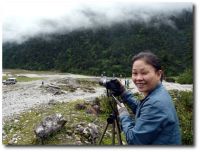 little village on the hill-side. It has many hotels, serving as transit
points for people visiting Yumthang Valley. We dump our luggage in the
room and rush off to look for flowers before it get too dark for photography.
We spot a few flowers which were new to us, a small shrub of white
Rhododendron flowers, and the Sikkim Aster. We also spot an apple species
found in Sikkim, called Sikkim Crabapple. During the walk we find a dhaba,
and ask for tea. It is served with pleasant smiles. We come back to our
hotel and the hotel lady is angry that we went and had paid tea, while
she had made free tea for us (part of the package).
little village on the hill-side. It has many hotels, serving as transit
points for people visiting Yumthang Valley. We dump our luggage in the
room and rush off to look for flowers before it get too dark for photography.
We spot a few flowers which were new to us, a small shrub of white
Rhododendron flowers, and the Sikkim Aster. We also spot an apple species
found in Sikkim, called Sikkim Crabapple. During the walk we find a dhaba,
and ask for tea. It is served with pleasant smiles. We come back to our
hotel and the hotel lady is angry that we went and had paid tea, while
she had made free tea for us (part of the package).
The Yumthang Valley
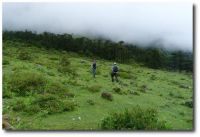 We get up at 5 in the morning, and go for a brisk walk outside. We can seen
partially snow-covered peaks close by, and the expanse of greenery is
really soothing. In such moments there is an envy for people who stay
in this village, and enjoy the beauty and greenery every day. We come back,
and a cup of tea is waiting for us. We leave our luggage in the hotel room,
and get into the vehicle for the drive to Yumthang Valley. The morning is
beautiful and the path is enchanting, passing over mountain streams,
with lush slopes on the sides. During the drive we look for flowers,
and we spot the Himalayan Yellow Poppy, which we have been search for,
for many years. It is a high altitude Himalayan plant. Girija is already
breathless with excitement. We see big stretches of Rhododendron forests
on both sides of the paths. Rhododendrons are gregarious plants, and a single
species covers a big stretch of land. We can see
We get up at 5 in the morning, and go for a brisk walk outside. We can seen
partially snow-covered peaks close by, and the expanse of greenery is
really soothing. In such moments there is an envy for people who stay
in this village, and enjoy the beauty and greenery every day. We come back,
and a cup of tea is waiting for us. We leave our luggage in the hotel room,
and get into the vehicle for the drive to Yumthang Valley. The morning is
beautiful and the path is enchanting, passing over mountain streams,
with lush slopes on the sides. During the drive we look for flowers,
and we spot the Himalayan Yellow Poppy, which we have been search for,
for many years. It is a high altitude Himalayan plant. Girija is already
breathless with excitement. We see big stretches of Rhododendron forests
on both sides of the paths. Rhododendrons are gregarious plants, and a single
species covers a big stretch of land. We can see
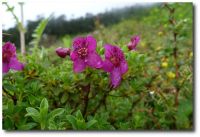 some foot-paths with signboards "Rhododendron niveum trail", "Rhododendron
ciliatum trail" etc. These are trails which people coming to Yumthang
in April-May follow. During those months, most of the Rhododendrons are
flowering, and it looks like a forest on floral fire. In the present
month (June), Rhododendron flowering is over, but the flowering of small
Himalayan plants has begun, which we are after.
some foot-paths with signboards "Rhododendron niveum trail", "Rhododendron
ciliatum trail" etc. These are trails which people coming to Yumthang
in April-May follow. During those months, most of the Rhododendrons are
flowering, and it looks like a forest on floral fire. In the present
month (June), Rhododendron flowering is over, but the flowering of small
Himalayan plants has begun, which we are after.
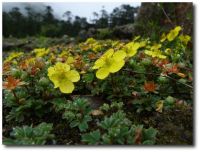
We reach the entrance to Yumthang Valley and get down there. Actually
the road goes right through the Valley. There are two rows of dhabas
on either side of the road at the entrance. We are supposed to have our
free breakfast in one of them. But we decide to explore the Valley first,
and break off from the rest of our co-passengers. Entering the Valley,
we come across a breathtaking view. A flat grassy valley in the middle,
a mountain river flowing through it, and lush green mountains covered with
trees and vegetation on both sides. We stand there speechless for a while,
taking in the view. Then we climb on to the slopes, to look for flowers.
Indeed, the Himalayan Yellow Poppy is right there. We had travelled to
Tawang, and the Valley of Flowers in Uttarakhand, but could not find it.
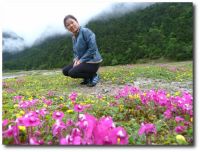 Now here it was, and we photograph it, and get ourselves photographed with it.
There are small Pink Scaly Rhododendrons which are still flowering on
the slopes. We find another Rhododendron species, with pale yellow bell-shaped flowers,
which we cannot identify immediately. Then there are beautiful wildflowers
called Avens - we find two varieties with yellow and white flowers.
There is a curious looking Griffith's Cobra Lily growing widely there.
The flowers look like the hood of a cobra.
Now here it was, and we photograph it, and get ourselves photographed with it.
There are small Pink Scaly Rhododendrons which are still flowering on
the slopes. We find another Rhododendron species, with pale yellow bell-shaped flowers,
which we cannot identify immediately. Then there are beautiful wildflowers
called Avens - we find two varieties with yellow and white flowers.
There is a curious looking Griffith's Cobra Lily growing widely there.
The flowers look like the hood of a cobra.
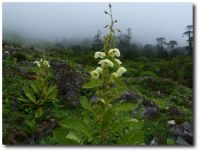 A closer look reveals more flowers, small in size, but beautiful nevertheless.
There are some tiny yellow Buttercups, and some species of Clematis vine.
We almost miss the tiny, but extremely pretty flowers called Forget-Me-Not.
There are pink Geraniums, unlike any ones we have seen before.
The more we explore, the more we find. We spend more than an hour on the
slopes, and then decide to come down to the grassy plains. A wonderful
sight awaits us there too. The grass throughout the Valley is covered
intermittently with tiny pink and yellow flowers. Pink flowers are mostly
Pedicularis,
commonly called Louseworts, and the yellow ones are Cinqefoils. We stroll
through this charming expanse of greenery, dotted with wonderful wildflowers,
and watch the river which is flowing through the Valley. This river actually
goes and merges with the Teesta river which flows through Sikkim, and
into West Bengal.
A closer look reveals more flowers, small in size, but beautiful nevertheless.
There are some tiny yellow Buttercups, and some species of Clematis vine.
We almost miss the tiny, but extremely pretty flowers called Forget-Me-Not.
There are pink Geraniums, unlike any ones we have seen before.
The more we explore, the more we find. We spend more than an hour on the
slopes, and then decide to come down to the grassy plains. A wonderful
sight awaits us there too. The grass throughout the Valley is covered
intermittently with tiny pink and yellow flowers. Pink flowers are mostly
Pedicularis,
commonly called Louseworts, and the yellow ones are Cinqefoils. We stroll
through this charming expanse of greenery, dotted with wonderful wildflowers,
and watch the river which is flowing through the Valley. This river actually
goes and merges with the Teesta river which flows through Sikkim, and
into West Bengal.

The tour is supposed to go further to a place called Zero-Point. Zero-Point is at
an astounding altitude of more than 5,000 m, and one can find snow even in
early June. From there, the flat Tibetan plateau is visible. Our
co-passengers turn out to be extremely disinterested - they came to Yumthang
without realizing what exactly it was, and are cribbing about there not
being much to see and the travel being so long. They are not interested in
going to Zero-Point. That suits us too - we want to spend as much time
in the Yumthang Valley as we can. We explore the grassy plains and find more
flowers. Red Himalayan Strawberries dot the whole expanse, especially the
slopes. We know they are edible and pick up a few to eat. Then there are
Himalayan roses, which are mostly climbing shrubs, that are there everywhere.
There is one with pink flowers, Webb's Rose, and one with white flowers,
Silky Rose, with tiny leaves. There are Rhubarb plants with big leaves.
For us it is a treasure trove, and nature's paradise.
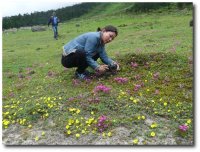
We do not feel like walking out of the paradise, but as it is getting late
we walk back to our dhaba, and have a breakfast of tea, bread and jam.
We can see there are other stalls, which are also busy catering to other
groups which have come to visit Yumthang. Interestingly, the dhaba ladies
are all clad in jeans and t-shirts, something we don't expect to see
in villages in north-India. Our vehicles starts driving back to Lachung,
but we feel we haven't had our fill. We ask the driver to drop us two km
before our hotel, and we will walk the rest of the way. We take the stroll
back and enjoy the scenery. And we find some new and interesting flowers.
 There are some showy rose-colored flowers in pendulous clusters. We suspect
them of being cultivated garden flowers, but they later turn out to be a
rare species of Butterfly-Bush, which is found only in Eastern Himalayas.
We find a species of Hydrangea, which grows as a tree. We find a few more
flowers new to us. The place amazes us with its floral diversity.
There are some showy rose-colored flowers in pendulous clusters. We suspect
them of being cultivated garden flowers, but they later turn out to be a
rare species of Butterfly-Bush, which is found only in Eastern Himalayas.
We find a species of Hydrangea, which grows as a tree. We find a few more
flowers new to us. The place amazes us with its floral diversity.
We come back to the hotel, rest a bit, and have an early lunch, and
start the drive back towards Gangtok. The drive back is uneventful,
but shorter because of the downhill travel. We break the journey for
a snack, and continue again. We reach Gangtok in the evening and check
into the same hotel that we left. As we lay in our beds after a hot shower,
the beautiful flowers of Yumthang Valley and its serene slopes refuse
to leave our mental eye. Hours after arriving, we still roam about in
an enchanted state.
Send feedback to: Tabish (tabishq gmail.com)
gmail.com)
 little village on the hill-side. It has many hotels, serving as transit
points for people visiting Yumthang Valley. We dump our luggage in the
room and rush off to look for flowers before it get too dark for photography.
We spot a few flowers which were new to us, a small shrub of white
Rhododendron flowers, and the Sikkim Aster. We also spot an apple species
found in Sikkim, called Sikkim Crabapple. During the walk we find a dhaba,
and ask for tea. It is served with pleasant smiles. We come back to our
hotel and the hotel lady is angry that we went and had paid tea, while
she had made free tea for us (part of the package).
little village on the hill-side. It has many hotels, serving as transit
points for people visiting Yumthang Valley. We dump our luggage in the
room and rush off to look for flowers before it get too dark for photography.
We spot a few flowers which were new to us, a small shrub of white
Rhododendron flowers, and the Sikkim Aster. We also spot an apple species
found in Sikkim, called Sikkim Crabapple. During the walk we find a dhaba,
and ask for tea. It is served with pleasant smiles. We come back to our
hotel and the hotel lady is angry that we went and had paid tea, while
she had made free tea for us (part of the package).












